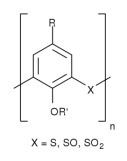 | ||
A Thiacalixarene is a macrocycle or cyclic oligomer based on a condensation product of a phenol derivative and sulfur. The word thiacalixarene is derived from thia (as sulfur) and calixarene. Thiacalixarenes have hydrophobic cavities that can hold smaller molecules or ions and belong to the class of cavitands known in Host-guest chemistry. Thiacalixarene nomenclature is straightforward and involves counting the number of repeating units in the ring and include it in the name. A calix[4]arene has 4 units in the ring and a calix[6]arene has 6.
Contents
Synthesis
Thiacalixarenes are synthetized using phenol derivatives and sulfur. The chemical reaction ranks under electrophilic aromatic substitutions followed by an elimination of water and then a second aromatic substitution. The reaction is base catalysed. Calixarenes are difficult to separate because it is all too easy to end up with complex mixtures of linear and cyclic oligomers with different numbers of repeating units. With finely tuned starting materials and reaction conditions synthesis can also be surprisingly easy.
Structure
Thiacalixarenes, like calixarene are characterised by a three-dimensional basket (vase or chalice shape). In thiacalix[4]arene derivatives, the internal volume is around 10 cubic nanometers. Thiacalix[4]arenes are characterised by a wide upper rim and a narrow lower rim. With phenol as a starting material, the 4 hydroxyl groups are intrannular on the lower rim. The basket form (cone conformation) is stabilized by hydrogen bonding between the four hydroxyl group. In case of substituted hydroxyl group, other conformers can be observed, like 1,2 or 1,3 alternate.
